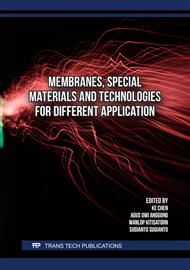[1]
N. Sumrith, L. Techawinyutham, M.R. Sanjay, R. Dangtungee, S. Siengchin, Characterization of Alkaline and Silane Treated Fibers of 'Water Hyacinth Plants' and Reinforcement of 'Water Hyacinth Fibers' with Bioepoxy to Develop Fully Biobased Sustainable Ecofriendly Composites, J. Polym. Environ. 28 (2020) 2749–2760.
DOI: 10.1007/s10924-020-01810-y
Google Scholar
[2]
A. Ajithram, J.T. Winowlin Jappes, N.C. Brintha, Water hyacinth (Eichhornia crassipes) natural composite extraction methods and properties – A review, Mater. Today Proc. 45 (2021) 1626–1632.
DOI: 10.1016/j.matpr.2020.08.472
Google Scholar
[3]
W. Su, Q. Sun, M. Xia, Z. Wen, Z. Yao, The Resource Utilization of Water Hyacinth (Eichhornia crassipes [Mart.] Solms) and Its Challenges, Resources 7 (2018) 46.
DOI: 10.3390/resources7030046
Google Scholar
[4]
S. Patel, Threats, management and envisaged utilizations of aquatic weed Eichhornia crassipes: an overview, Rev. Environ. Sci. Bio/Technology 11 (2012) 249–259.
DOI: 10.1007/s11157-012-9289-4
Google Scholar
[5]
A. Ajithram, J.T.W. Jappes, S. Vignesh, Smart and Sustainable Product Development from Environmentally Polluted Water Hyacinth (Eichhornia Crassipes) Plant, in: 2023: p.339–350.
DOI: 10.1007/978-981-19-5327-9_16
Google Scholar
[6]
M.R. Sanjay, P. Madhu, M. Jawaid, P. Senthamaraikannan, S. Senthil, S. Pradeep, Characterization and properties of natural fiber polymer composites: A comprehensive review, J. Clean. Prod. 172 (2018) 566–581.
DOI: 10.1016/j.jclepro.2017.10.101
Google Scholar
[7]
F. Li, X. He, A. Srishti, S. Song, H.T.W. Tan, D.J. Sweeney, S. Ghosh, C.-H. Wang, Water hyacinth for energy and environmental applications: A review, Bioresour. Technol. 327 (2021) 124809.
DOI: 10.1016/j.biortech.2021.124809
Google Scholar
[8]
R.K. Opu, M.R. Hossain, M.S.H. Monir, R.H. Shanto, M.S. Osman, Co-liquefaction of faecal sludge and water hyacinth: Exploring the fuel characteristics of biocrude including thermal maturation and petroleum fractionation, Biomass and Bioenergy 173 (2023) 106785.
DOI: 10.1016/j.biombioe.2023.106785
Google Scholar
[9]
S.L. Wright, F.J. Kelly, Plastic and Human Health: A Micro Issue?, Environ. Sci. Technol. 51 (2017) 6634–6647.
DOI: 10.1021/acs.est.7b00423
Google Scholar
[10]
C.I. Idumah, I.C. Nwuzor, Novel trends in plastic waste management, SN Appl. Sci. 1 (2019) 1402.
DOI: 10.1007/s42452-019-1468-2
Google Scholar
[11]
P. Dong, Y. Ye, Y. Zhang, Renewable polymers to help human sustainable development under the current situation of fossil resource depletion, in: T. Palanisamy, L. Boon Han (Eds.), Eighth Int. Conf. Energy Mater. Electr. Eng. (ICEMEE 2022), SPIE, 2023: p.93.
DOI: 10.1117/12.2673036
Google Scholar
[12]
Everything you need to know about plastic pollution, Chem. Pollut. Action (2023).
Google Scholar
[13]
J. Simon, H.P. Müller, R. Koch, V. Müller, Thermoplastic and biodegradable polymers of cellulose, Polym. Degrad. Stab. 59 (1998) 107–115.
DOI: 10.1016/s0141-3910(97)00151-1
Google Scholar
[14]
V.K. Thakur, M.K. Thakur, Processing and characterization of natural cellulose fibers/thermoset polymer composites, Carbohydr. Polym. 109 (2014) 102–117.
DOI: 10.1016/j.carbpol.2014.03.039
Google Scholar
[15]
C. Uma Maheswari, K. Obi Reddy, E. Muzenda, B.R. Guduri, A. Varada Rajulu, Extraction and characterization of cellulose microfibrils from agricultural residue – Cocos nucifera L., Biomass and Bioenergy 46 (2012) 555–563.
DOI: 10.1016/j.biombioe.2012.06.039
Google Scholar
[16]
S. Anantachaisilp, S. Siripromsombut, T. Ruansoong, T. Kwamman, An eco-friendly bioplastic film obtained from water hyacinth, J. Phys. Conf. Ser. 1719 (2021) 012110.
DOI: 10.1088/1742-6596/1719/1/012110
Google Scholar
[17]
M. Mahardika, H. Abral, D. Amelia, Recent Developments in Water Hyacinth Fiber Composites and Their Applications, in: 2023: p.229–243.
DOI: 10.1007/978-981-19-5327-9_11
Google Scholar
[18]
S. Rezania, M. Ponraj, M.F.M. Din, A.R. Songip, F.M. Sairan, S. Chelliapan, The diverse applications of water hyacinth with main focus on sustainable energy and production for new era: An overview, Renew. Sustain. Energy Rev. 41 (2015) 943–954.
DOI: 10.1016/j.rser.2014.09.006
Google Scholar
[19]
H.A. Vang, Q.V. Tran, P.N. Le, N.A.T. Huynh, V.V.L. Nguyen, Fabrication of biodegradable masks from banana leaves by thermal compression method, Minist. Sci. Technol. Vietnam 65 (2023) 31–36.
Google Scholar
[20]
ASTM International - ASTM D882-18 Standard Test Method for Tensile Properties of Thin Plastic Sheeting, ASTM Int. (2018).
Google Scholar
[21]
ASTM International (2018), ASTM D570-98: Standard Test Method for Water Absorption of Plastics, ASTM Int. (1998).
Google Scholar
[22]
R.S. Akshana, N. Sobini, T. Kirushanthi, S. Srivijeindran, Synthesis of cellulose nano fiber from palmyrah fruit fiber and its applicability as a reinforcement agent on starch based biodegradable film, Ceylon J. Sci. 53 (2024) 313–320.
DOI: 10.4038/cjs.v53i3.8257
Google Scholar
[23]
P. Pantamanatsopa, W. Ariyawiriyanan, S. Ekgasit, Production of Cellulose Nanocrystals Suspension with High Yields from Water Hyacinth, J. Nat. Fibers 20 (2023).
DOI: 10.1080/15440478.2022.2134266
Google Scholar
[24]
K. Song, X. Zhu, W. Zhu, X. Li, Preparation and characterization of cellulose nanocrystal extracted from Calotropis procera biomass, Bioresour. Bioprocess. 6 (2019) 45.
DOI: 10.1186/s40643-019-0279-z
Google Scholar
[25]
T.T. Van Nguyen, N. Tri, B.A. Tran, T. Dao Duy, S.T. Nguyen, T.-A. Nguyen, A.N. Phan, P. Mai Thanh, H.K.P. Huynh, Synthesis, Characteristics, Oil Adsorption, and Thermal Insulation Performance of Cellulosic Aerogel Derived from Water Hyacinth, ACS Omega 6 (2021) 26130–26139.
DOI: 10.1021/acsomega.1c03137
Google Scholar
[26]
K. Pakutsah, D. Aht-Ong, Facile isolation of cellulose nanofibers from water hyacinth using water-based mechanical defibrillation: Insights into morphological, physical, and rheological properties, Int. J. Biol. Macromol. 145 (2020) 64–76.
DOI: 10.1016/j.ijbiomac.2019.12.172
Google Scholar
[27]
A.R. Martin, M.A. Martins, O.R.R.F. da Silva, L.H.C. Mattoso, Studies on the thermal properties of sisal fiber and its constituents, Thermochim. Acta 506 (2010) 14–19.
DOI: 10.1016/j.tca.2010.04.008
Google Scholar
[28]
X. Li, L.G. Tabil, S. Panigrahi, Chemical Treatments of Natural Fiber for Use in Natural Fiber-Reinforced Composites: A Review, J. Polym. Environ. 15 (2007) 25–33.
DOI: 10.1007/s10924-006-0042-3
Google Scholar


